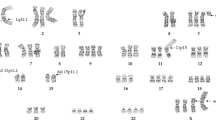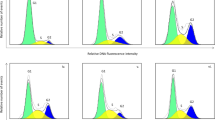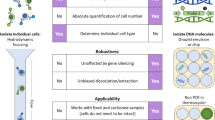Abstract
Chromosomes from antigen stimulated B–cells from spleens of inbred mice have been separated using flow cytometry into 18 distinguishable peaks. Using locus–specific oligonucleotides and fluorescence in situ hybridization to banded metaphase spreads, 15 individual chromosomes were identified: 1, 2, 3, 6, 7, 8, 9, 11, 12, 16, 17, 18, 19, X and Y. The remaining six chromosomes, occurring as pairs in three peaks, 4 with 5, 10 with 13, and 14 with 15, were resolved by flow sorting chromosomes from mice carrying an appropriate homozygous translocation and 4, 5 and 14 have been isolated in this way. This is the first demonstration of how a complete set of mouse chromosome paints can be produced.
This is a preview of subscription content, access via your institution
Access options
Subscribe to this journal
Receive 12 print issues and online access
$209.00 per year
only $17.42 per issue
Buy this article
- Purchase on Springer Link
- Instant access to full article PDF
Prices may be subject to local taxes which are calculated during checkout
Similar content being viewed by others
References
Carter, N.P. Cytogenetic analysis by chromosome painting. Cytometry 18, 2–10 (1994).
Scherthan, H. et al. Comparative chromosome painting discloses homologous segments in distantly related mammals. Nature Genet. 6, 342–347 (1994).
Hoebee, B., de Stoppelaar, J.M., Suijkerbuijk, R. F. & Monard, S. Isolation of rat chromosome-specific paint probes by bivariate flow sorting followed by degenerate oligonucleotlde primed-PCR. Cytogenet. Cell Genet. 66, 277–282 (1994).
Yerle, M. et al. Accurate characterization of porcine bivariate flow karyotype by PCR and fluorescence in situ hybridization. Genomics 16, 97–103 (1993).
Langford, C.F., Telenius, H, Milter, N.G., Thomson, P.D. & Tucker, E.M. Preparation of chromosome-specific paints and complete assignment of chromosomes In the pig flow karyotype. An. Genet. 24, 261–267 (1993).
Cowell, J. A photographic representation of the variability in the G-banded structure of the chromosomes in the mouse karyotype. Aguide to theidentification of the individual chromosomes. Chromosoma. 88, 294–320 (1984).
Weier, H.-U. et al. Generation of five high-complexity painting probe libraries from flow-sorted mouse chromosomes. Genomics. 21, 641–644 (1994).
Breneman, W. et al. The development of chromosome-specific composite DNA probes for the mouse and their application to chromosome painting. Chromosoma 102, 591–598 (1993).
Miyashfta, K. et al. A mouse chromosome 11 library generated from sorted chromosomes using linker-adapter polymerase chain reaction. Cytogenet. Cell Genet. 66, 54–57, (1994).
Comall, R.J., Friedman, J.M. & Todd, J.A. Mouse microsatellites from aflow-sorted 4:6 Robertsonian chromosome. Mamm. Genome, 3, 620–624 (1992).
Dietrich, W. et al. Genetics Maps. (ed. O'Brien, S. J. ) (Cold Spring Harbor Laboratory Press, New York, 1992).
Telenius, H. et al. Degenerate oligonucleotide-primed PCR: general amplification of target DNA by a single degenerate primer. Genomics, 13, 718–725 (1992).
Davisson, M.T. Centromeric heterochromatin variants. In Genetic Variants & Strains of theLaboratoiy Mouse. (EdsM. F. L & Searle,A. G. ) 617–618 (Oxford University Press, 1989).
Mayall, B.H. et al. The DMA-based human karyotype. Cytometry 5, 376–385 (1984).
Kenter, A.L., Watson, J.V., Azin, T. & Rabbitts, T.H. Colcemid inhibits growth during early G1 in normal but not in tumorigenic lymphocytes. Exp. Cell. Res., 167, 241–251 (1986).
Sillar, R. & Young, B.D. A new method for the preparation of metaphase chromosomes for flow cytometry. J. Histocnem. Cytochem. 29, 74–78 (1981).
Carter, N.P. Bivariate chromosome analysis using a commercial flow cytometer. Chromosome Analysis Protocols, (ed. Gosden, J. R. ) (Humana Press, Totowa, 1994).
Carter, N.P. Chromosome painting using degenerate oligonuclotide-primed polymerase chain reaction-amplified, flow sorted chromosomes. In Cell Biology: A Laboratory Handbook, (ed. Celis, J. E. ) 442–449 (Academic Press, San Diego, 1994).
Verma, R.S. & Babu, A. Human Chromosomes Manual of Basic Techniques. (Pergamon Press, New York, 1989).
Evans, E.P. Karyotyping and sexing of gametes, embryos and fetuses and in situ hybridisation to chromosomes. In Mammalian Development. A Practical Approach, (ed. Monk, M. ) 93–114 (IRL Press, Oxford, 1987).
Wienberg, J., Jauch, A., Stanyon, R. & Cremer, T. Molecular cytotaxonomy of primates by chromosomal in situ suppression hybridization. Genomics 8, 347–350 (1990).
Author information
Authors and Affiliations
Rights and permissions
About this article
Cite this article
Rabbitts, P., Impey, H., Heppell-Parton, A. et al. Chromosome specific paints from a high resolution flow karyotype of the mouse. Nat Genet 9, 369–375 (1995). https://doi.org/10.1038/ng0495-369
Received:
Accepted:
Issue Date:
DOI: https://doi.org/10.1038/ng0495-369



